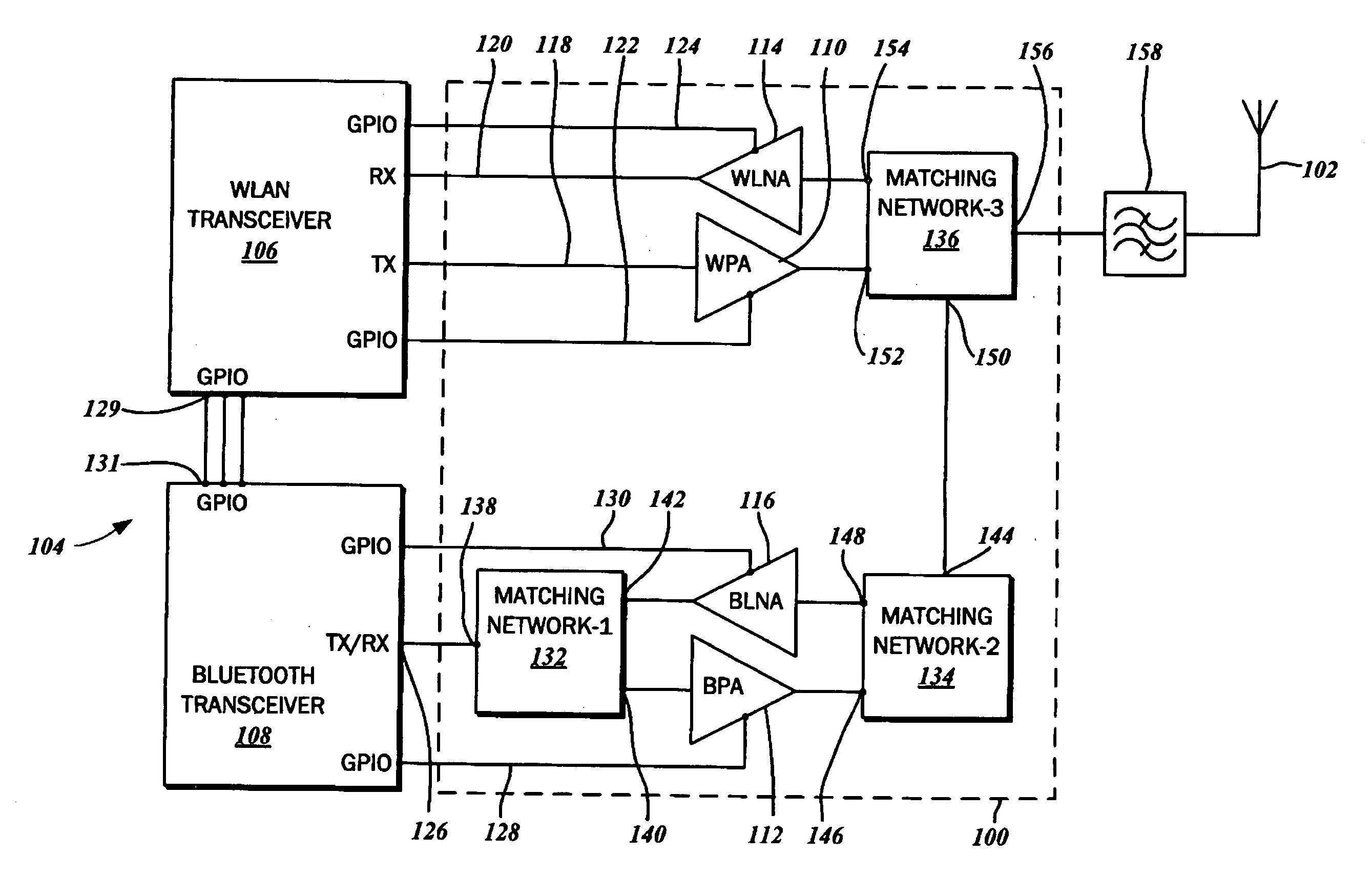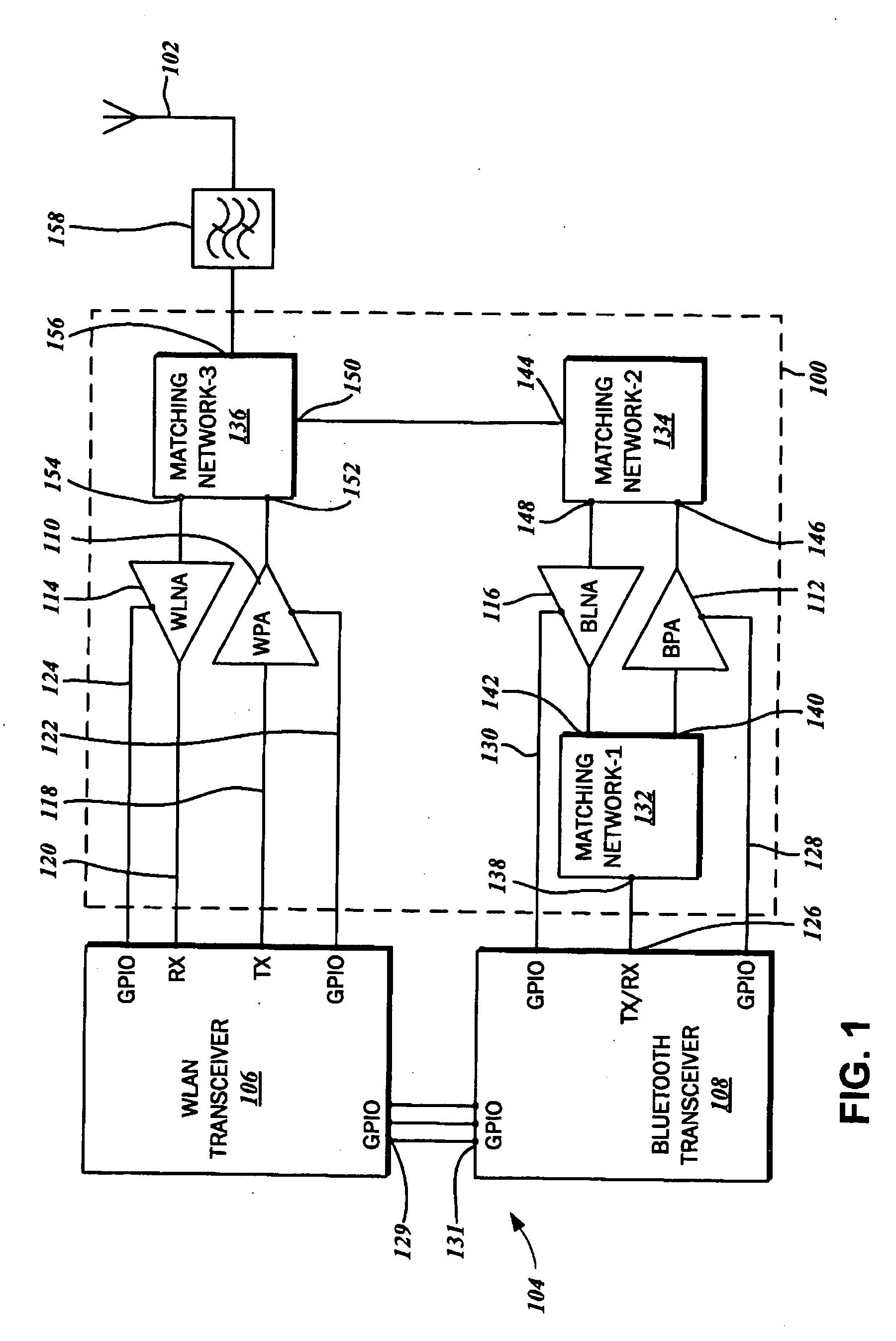Multi mode radio frequency transceiver front end circuit
a transceiver and front end technology, applied in the field of single-band transmitreceiver front end integrated circuits, can solve the problems of reducing efficiency, reducing power, and difficult to achieve +20 dbm power levels at 1.8v,
- Summary
- Abstract
- Description
- Claims
- Application Information
AI Technical Summary
Benefits of technology
Problems solved by technology
Method used
Image
Examples
first embodiment
[0048]As best illustrated in FIG. 2A, a first embodiment contemplates the band pass filter 158 being disposed between the front end circuit 100 and the antenna 102. More particularly, the band pass filter 158 includes a first port 160 that is connected to the front end circuit, and a second port 162 that is coupled to the antenna 102. Referring back to the block diagram of FIG. 1, the first port 160 of the band pass filter may be coupled to a fourth port 156 of the third matching network 136. The band pass filter 158 is typically a low temperature co-fired ceramic (LTCC) or may be an integrated passive device (IPD / IPAD) that is fabricated on a GaAs substrate without an epitaxial layer, a sapphire substrate, or a glass substrate.
[0049]In a second embodiment shown in FIG. 2B, a first band pass filter 158a is disposed between the WLAN transceiver 106 and the front end circuit 100, and a second band pass filter 158b is disposed between the Bluetooth transceiver 108 and the front end cir...
second embodiment
[0078]With reference to the circuit diagram of FIG. 4, the front end circuit 100b is generally defined by a WLAN transmit block 300, a WLAN receive block 302, and a combined Bluetooth block 304. The various subparts thereof are understood to correspond to the aforementioned power amplifiers 110, 112, low noise amplifiers 114, 116, and the matching networks 132, 134, and 136, as will be detailed more fully below. The WLAN transmit block 300 includes the TX (transmit) port 170 that is connected to the WLAN transmit line 118, and the WLAN receive block 302 includes an RX (receive) port 172 that is connected to the WLAN receive line 120. Additionally, the Bluetooth block 304 includes the shared TX / RX port 174 that is connected to the common transmit and receive line 126 of the Bluetooth transceiver 108. The front end circuit 100b also includes an antenna port 175 associated with each of the WLAN transmit block 300, the WLAN receive block 302, and the combined Bluetooth block 304. The an...
third embodiment
[0091]Referring now to the schematic diagram of FIG. 5, the front end circuit 100c is defined by a WLAN transmit block 324, a WLAN receive block 326, and a combined Bluetooth block 328. The various subparts thereof are understood to correspond to the power amplifiers 110, 112, low noise amplifiers 114, 116, and the matching networks 132, 134, and 136, as will be detailed more fully below. The WLAN transmit block 324 includes the TX (transmit) port 170 that is connected to the WLAN transmit line 118, and the WLAN receive block 326 includes an RX (receive) port 172 that is connected to the WLAN receive line 120. Additionally, the Bluetooth block 328 includes the shared TX / RX port 174 that is connected to the common transmit and receive line 126 of the Bluetooth transceiver 108. The front end circuit 100c also includes an antenna port 175 associated with each of the WLAN transmit block 324, the WLAN receive block 326, and the combined Bluetooth block 328. The antenna matching block 169...
PUM
 Login to View More
Login to View More Abstract
Description
Claims
Application Information
 Login to View More
Login to View More - R&D
- Intellectual Property
- Life Sciences
- Materials
- Tech Scout
- Unparalleled Data Quality
- Higher Quality Content
- 60% Fewer Hallucinations
Browse by: Latest US Patents, China's latest patents, Technical Efficacy Thesaurus, Application Domain, Technology Topic, Popular Technical Reports.
© 2025 PatSnap. All rights reserved.Legal|Privacy policy|Modern Slavery Act Transparency Statement|Sitemap|About US| Contact US: help@patsnap.com



